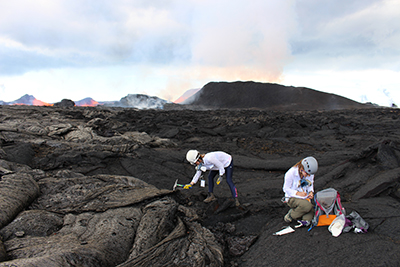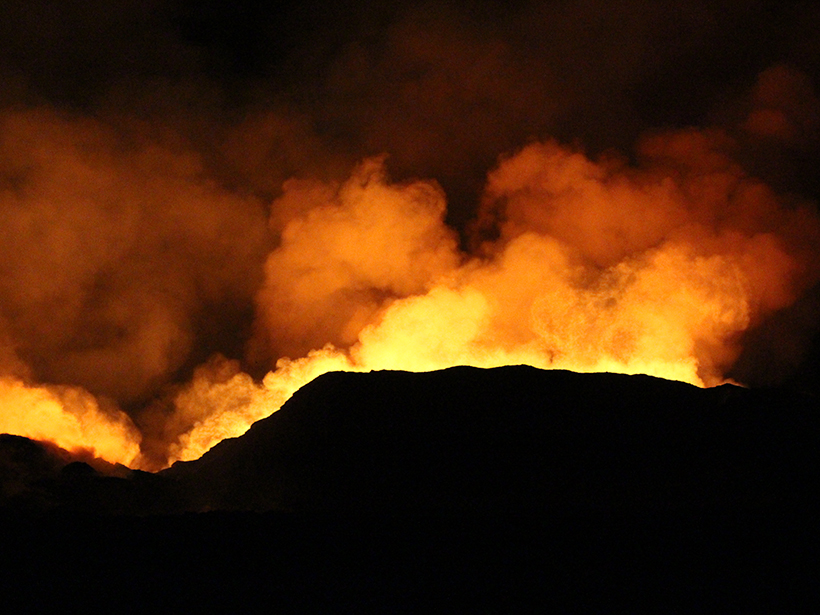The data collected by Wieser and others in 2018 are still providing new insights about the volcano, which could help scientists better understand volcanic systems around the world.
By the time Penny Wieser arrived on the Big Island of Hawai‘i in July 2018, the biggest eruption of Kīlauea volcano in 200 years had mostly stabilized. For Wieser, then a Ph.D. student at the University of Cambridge, it was still the opportunity of a lifetime.
Even before the eruption, Kīlauea was the best monitored volcano on the planet. But the data collected by Wieser and others in 2018 are still providing new insights about the volcano, which could help scientists better understand volcanic systems around the world.
In a new study published in Geochemistry, Geophysics, Geosystems, Wieser, now a postdoc at Oregon State University, and her colleagues looked at melt inclusions—blobs of frozen magma that are made of glass and vapor bubbles and become trapped within rock-forming olivine crystals—to better understand the source of the magma during the 2018 eruption. The work is also helping to resolve a long-standing inconsistency between geophysical and geochemical studies of Kīlauea’s reservoirs.
A Tale of Two Reservoirs
Geophysical studies long ago revealed that there are two main magma reservoirs below Kīlauea: a shallow reservoir some 0.5–2 kilometers beneath the eastern rim of Halema‘uma‘u crater and a deeper reservoir 3–5 kilometers beneath the southern region of the caldera. Geochemical techniques can also give researchers a sense of reservoir depth. More specifically, the amount of carbon dioxide in a melt inclusion is a function of pressure and thus of depth.
But previous studies that estimated reservoir depths at Kīlauea on the basis of melt inclusions didn’t always agree with the widely accepted geophysical findings about the location of Kīlauea’s reservoirs.
That’s because until recently, researchers were measuring the carbon dioxide only in the glass portion of melt inclusions and ignoring the carbon dioxide present in tiny vapor bubbles stuck in the melt, according to Robert Bodnar, a professor of geochemistry at Virginia Polytechnic Institute and State University who was not involved in the new study. “Part of that was that we just didn’t have analytical techniques available to analyze what was in the vapor bubbles,” Bodnar said. But geochemists knew that at least some carbon dioxide was there. Studies have shown that sometimes as much as 90% of the carbon dioxide in a sample can be found in the bubbles.
In the new study, Wieser and her colleagues looked at carbon dioxide in both the glass portion and the vapor bubbles of more than 100 melt inclusions from real-time lava samples collected from the 2018 eruption. Bodnar called it “the most comprehensive study to date.”
Early work on the 2018 eruption based on geophysical techniques (such as tilt measurements and GPS) all indicated that the shallower reservoir was the main source of magma for the eruption. However, this didn’t fully explain why Kīlauea’s eruption grew so suddenly in May. When Wieser took a closer look at the olivine crystals, she saw right away that they were large, primitive, and, most important, familiar. They resembled the crystals she had been studying from older Kīlauea eruptions throughout the 1960s and 1970s, but those crystals came from the deeper reservoir. To Wieser, the similarity between the crystals suggested that the deeper reservoir must have been involved in 2018 as well.
“That’s why we started down this route, to show that even though the monitoring data [were] showing that this upper reservoir was important, the actual eruptive crystals showed that this deeper reservoir was just as important in terms of supplying the magma we were seeing at the surface,” she said.

Twin Spectroscopy Studies
The team used Raman spectroscopy to measure the carbon dioxide in the bubbles and secondary-ion mass spectrometry to measure carbon dioxide in the glass portion of the melt inclusions to get a total carbon dioxide budget for Kīlauea melt inclusions.
Wieser and her colleagues saw that there were two distinct populations of melt inclusions: those that came from the deeper reservoir, deemed high-Fo melt inclusions based in part on the forsterite content of the olivine crystals, and those that came from the shallower reservoir, or low-Fo melt inclusions.
In the high-Fo melt inclusions, a greater proportion of the carbon dioxide budget was found in the vapor bubbles—as much as 99%. (On the other hand, in the melt inclusions in the low-Fo group, there was little to no carbon dioxide in the vapor bubbles.) Ignoring the vapor bubbles in those samples would have suggested formation depths of just 400 meters, according to Wieser. “There’s no macroreservoir of only 400 meters deep, but because we did Raman, we got depths of 2–5 kilometers, which matches exactly where this reservoir is,” Wieser said.
This means that in the future, researchers can identify which samples are likely to have more carbon dioxide in the glass and which will have more in the vapor bubbles and select the best technique to measure it. Ultimately, the method could save researchers time and money. Secondary-ion mass spectrometry can be expensive and logistically difficult, but according to Wieser, measuring the amount of carbon dioxide in these vapor bubbles is relatively easy and inexpensive with Raman.
Geochemical and Geophysical Data
The team also used the carbon dioxide budget data to evaluate techniques to theoretically reconstruct carbon dioxide in vapor bubbles that have been proposed to correct previous literature. Unfortunately, the researchers found that the techniques, called equation of state methods, can overestimate the amount of carbon dioxide by 10–20 times. “So if you’d have used those, you’d have ended up saying loads of melt in the 2018 eruption came from deeper than 5 kilometers,” Wieser said, “which would have required you to invoke another reservoir within the mantle or the crust.”
Finally, the study demonstrated how the analysis of eruptive material can complement geophysical studies. Although the initial geophysical data on the 2018 eruption suggested that the shallower reservoir at Kīlauea was the dominant source of magma, the analysis of the eruptive materials showed that the deeper reservoir was at least as important, just not as visible immediately. Considering both geochemical and geophysical data together can create a more complete picture of what’s going on within the depths of these volcanic systems.
“To get the level of geophysical data we have at Kīlauea is superexpensive….We don’t have that at other volcanoes around the world.”
In July 2018, the eruption came to an end, nearly as abruptly as it began. But in December 2020, a new eruption began. Most of the preliminary data suggest that the new eruptive material is coming from the shallower reservoir, so it’s unlikely that Raman would reveal much carbon dioxide in vapor bubbles for samples from the current eruption, according to Wieser.
It does raise some interesting questions for Wieser and others, though, including whether the role of the deeper magma chamber in 2018 can help to explain why that eruption was so large. That’s for future studies to find out.
In the meantime, the agreement on reservoir depth between the geophysical and geochemical studies is good news for researchers studying volcanic systems around the world. “To get the level of geophysical data we have at Kīlauea is superexpensive. They have so many seismometers; they have so many GPS stations. We don’t have that at other volcanoes around the world,” Wieser said. “So if we can be confident that the petrological methods of just taking a rock sample back to the lab can give us the same depths as the geophysics, then we know that those methods are reliable to use on less studied volcanoes.”
—Kate Wheeling (@katewheeling), Science Writer
Citation:
Wheeling, K. (2021), Insights from the depths of Hawaii’s Kīlauea volcano, Eos, 102, https://doi.org/10.1029/2021EO155761. Published on 11 March 2021.
Text © 2021. The authors. CC BY-NC-ND 3.0
Except where otherwise noted, images are subject to copyright. Any reuse without express permission from the copyright owner is prohibited.

